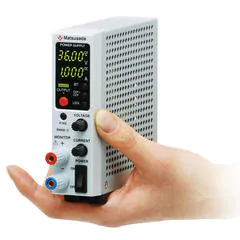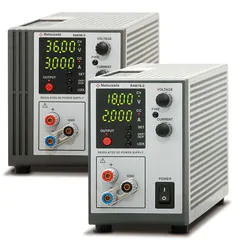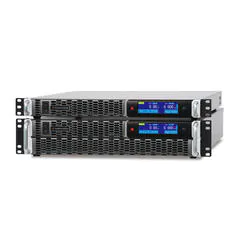What is a DC power supply?
The DC power supply is a device that creates and supplies a stable Direct Current (DC) from the AC power supply of the outlet. It is used as a power source to run electronic circuits or to check electronic devices.
For example, household power outlets in Japan are provided with 100V AC, but minute voltage fluctuations actually occur due to losses during the power supply and changes in power consumption of devices connected to the same power source.
Fluctuations in the voltage supplied to home appliances with relatively simple structures, such as vacuum cleaners and fans, do not pose much of a problem. However, for precision devices such as electronic equipment, a slight change in voltage can cause a malfunction.
Also, since DC power is required to run electronic devices, the supplied AC power must be converted to DC power. A DC stabilized power supply is used for this purpose.
Stabilized DC power supplies can be divided into two types depending on the output method: constant voltage power supplies and constant current power supplies. In constant-voltage power supplies, the output voltage is controlled so that it remains constant even if the power supply load changes. On the other hand, constant-current power supplies are controlled so that the output current remains constant.
The details of constant voltage and constant current power supplies are explained on this page.
Points to consider when selecting a DC stabilized power supply
When selecting a DC stabilized power supply, there are two main points to consider: output range and circuit method.
Output range
The output range of a DC regulated power supply differs greatly depending on whether it is a single-range or wide-range system.
A single-range power supply is a power supply in which the combination of voltage and current that can be output is determined by the rated voltage and rated current. For a stabilized DC power supply with a rated voltage of 80V and a rated current of 10A (PK80-10 (800W)), the maximum output voltage is 80V, the maximum output current is 10A, and the maximum output power is 800W.
On the other hand, a wide-range (variable-range) power supply is one in which the combination of voltage and current that can be output is determined by the power rating in addition to the rated voltage and current.
In the case of a regulated power supply (PKT80-50 (800W)) with a rated voltage of 80V, a rated current of 50A, and an output power of 800W, the current that can be output at the maximum output voltage of 80V is limited to 10A, which is less than 800W of power rating. Similarly, the voltage that can be output at the maximum output current of 50A is limited to 16V, and it is not possible to use a combination of maximum output voltage and maximum output current as in the single-range system.
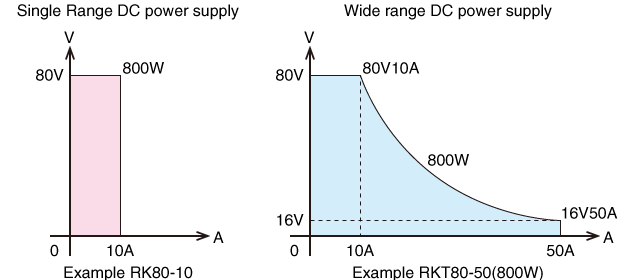
If you are choosing the same power rating, single-range power supplies are less expensive. If you always perform tests with a fixed current and voltage, it is better to choose a single-range power supply.
However, when checking electronic devices that require a large current only at start-up, such as motors or electronic devices powered by batteries whose output voltage drops as they run down, various combinations of voltage and current are required. Therefore, if you try to use a single-range power supply, you will need a lot of power supply units.
Also, if you prepare a single-range power supply that covers such a wide range, the cost will increase, and the size of the power supply will also increase. In such cases, a wide-range power supply can be chosen to save both cost and space. There are two types of wide-range power supplies: those with a wide output range and those with a narrow output range. The model shown in the example above is capable of 5 times wider range output. When choosing a power supply with wide-range power, be sure to check the range width.
In the past, single-range DC power supplies were the mainstream. In recent years, however, the demand for wide-range (variable-range) DC power supplies has been growing as more devices run on batteries, and more types of electronic devices are used.
AC to DC conversion methods
There are two types of circuits for DC regulated power supplies: dropper and switching.
The dropper method is also called the series method, linear method, series regulator method, linear regulator method, series dropper method, etc. The input Alternating Current (AC) is converted to Direct Current (DC), and then the voltage and current are controlled by a transformer and sent out. The switching method, on the other hand, converts the current converted to DC into high-frequency AC power using coils or semiconductors and then converts it back to DC to control the voltage and current.
The disadvantage of a switching type DC regulated power supply is that its mechanism generates minute noise. Therefore, it is not suitable for equipment that is easily affected by noise. On the other hand, the dropper method has the advantage of low noise and high responsiveness to changes in load. However, they also have the disadvantage of being large and heavy and generating a lot of heat.
Ordinary desktop computers also have a built-in switching DC power supply, but if you want to use a dropper system, you need a power supply as big as a toaster. For this reason, switching DC power supplies have become the norm in recent years.
When selecting a DC power supply, first determine the output range by checking the voltage and current required for operation, then check the effects of noise, responsiveness, and the operability of the equipment, and choose the best one for your application.
Guidelines for replacing a DC power supply
As wide-range power supplies have been widely used in recent years, the performance and functions of DC-regulated power supplies are advancing day by day.
Therefore, even if there are no particular problems with the DC stabilized power supply you are currently using, it is worth considering a new power supply if you have any of the following points.
- Large and requires a large space for installation
- Heavy, making it difficult to move
- Low efficiency and high power consumption
- Generates a lot of heat and the cooling fan is noisy.
- No meter or analog meter, so it takes time to read the values.
- Cannot be controlled remotely
- Analog control takes time to set and adjust.
The problems of size, weight, efficiency, and heat generation can be solved by changing the dropper-type power supply to a switching type. Also, in recent years, the user interface has dramatically improved with meters and remote control, making power supplies easier for everyone to use. Therefore, if you feel that your power supply is getting old, you may want to select a new power supply.
Guidelines for replacing a DC power supply
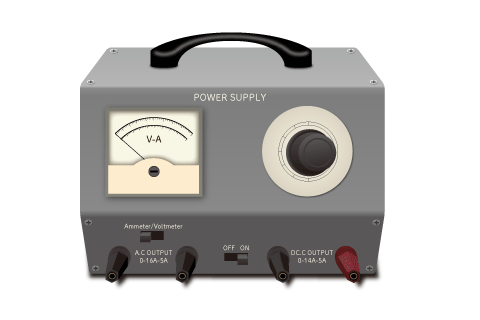
Old DC power supplies are
- Large and heavy (bulky and difficult to move)
- Low efficiency (high power consumption)
- High heat generation (noisy fan)
- No meter or analog meter
- No remote control
- Analog control takes time for setting and adjustment
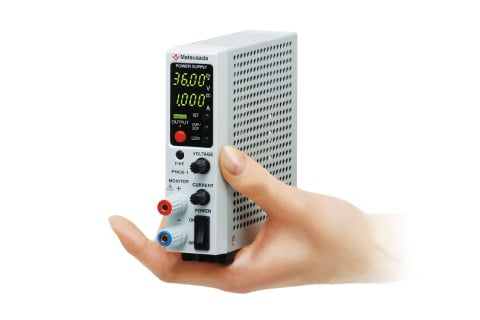
The latest DC power supplies are
- Compact and lightweight
- High efficiency
- Low heat generation
- Easy to set and adjust with digital control
- Remote control is possible
Precautions for using DC power supplies
So, what points should we pay attention to when using a DC-regulated power supply? Basically, regardless of whether the DC-regulated power supply is a dropper type or a switching type, it is important to ensure heat dissipation when using it. Using a power supply in a dusty place can also shorten its life.
In addition, check each point for trouble when using the product, depending on the situation.
If the unit does not start up properly the first time it is energized, the overcurrent protection may be activated. In this case, review the current setting of the DC power supply. It is a good idea to re-examine the current of the power supply, taking into account the inrush current flowing at the start-up of the load side.
If the input breaker tripped or the external fuse blew, the inrush current may have affected the system. In general, the inrush current of a regulated DC power supply flows several times to several tens of times higher than normal when energized. Recheck the inrush current of each regulated DC power supply and the specifications of the breakers and fuses.
If the problem persists after checking, contact the manufacturer's support desk. DC power supplies and other power supply-related devices can lead to serious problems if they break down, making it impossible for other devices to operate. It is best to choose a product from a manufacturer that is quick to respond and provides detailed support.
Related Technical Articles
Recommended products
Matsusada Precision's high-performance DC power supplies



